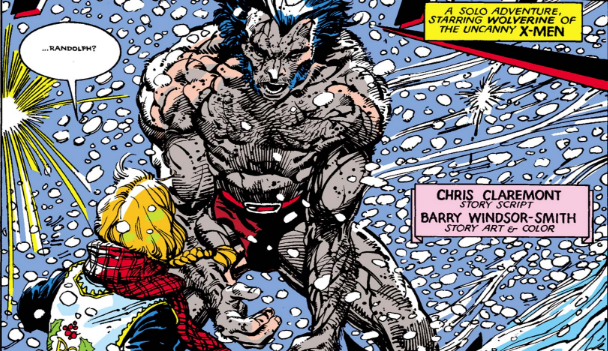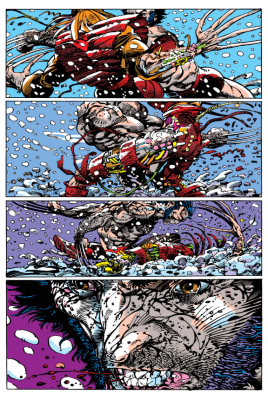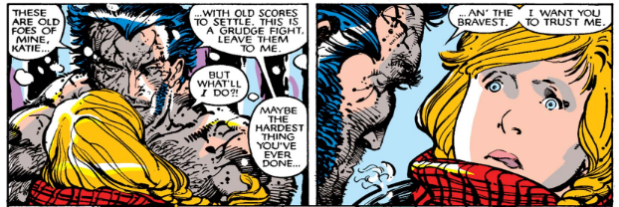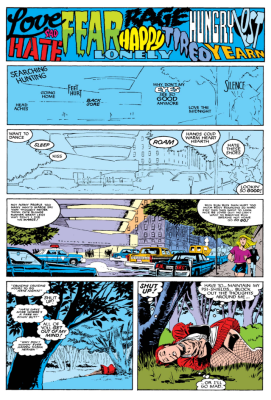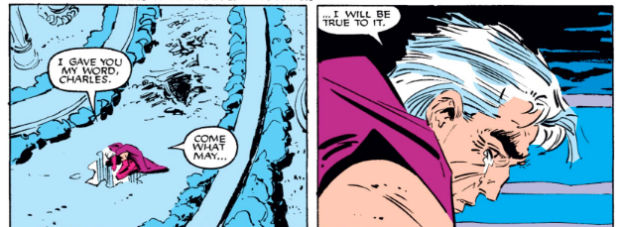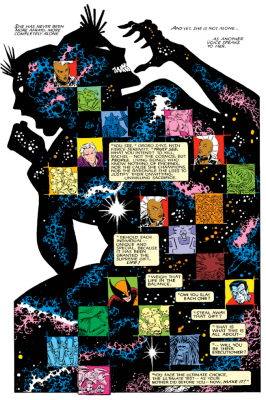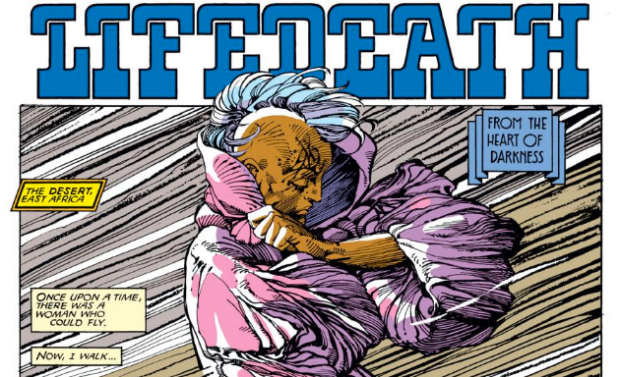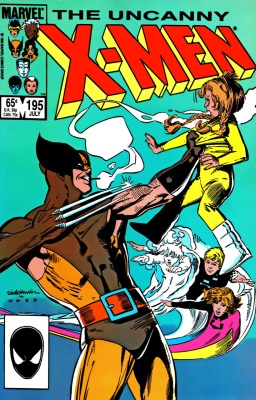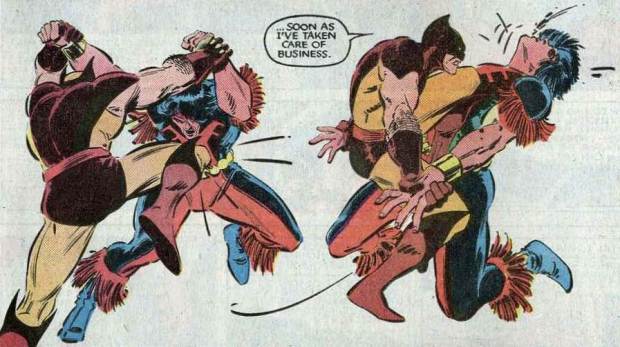Reading the entire Uncanny X-Men comic book series really illustrates how the team and its characters have evolved over time, and how they both reflect and influence comics of the time.
I’m now up to 1987, right after the first official X-Men crossover event Mutant Massacre, and the fall-out of that story sees a darker shift toward paranoia and a grim chance at a hopeful future for the characters. The specter of death and doom hangs over them more heavily now, and it’s affecting how they act. The art is also becoming more moody and intense with darker colors.
The industry as a whole was responding similarly to the previous year’s surprise hits, Alan Moore and Dave Gibbons’ Watchmen and Frank Miller’s Batman: The Dark Knight Returns. They redefined how comics creators approached telling superhero stories. While those two stories took a more dark and grim approach to superheroes, it was a tone used to enhance specific themes and devices that really made those two classic comics resonate. Ultimately, I think the industry learned the wrong lesson and replicated the wrong elements from these milestone works. Some creators got it, but too many devolved their stories into gritted teeth and anguish, mistaking it for realism, with no real foundation of character, thematic exploration or even structure. In improv comedy, players are encouraged to “play to the height of your intelligence,” and I think too many writers and artists did not write or draw to the height of their intelligence during this period. In the 1990s, the comics industry nearly drowned from this content. While Marvel’s X-Men franchise was far from the most guilty, it had its fair share of going for the low-hanging fruit. Fortunately X-Men as a concept and its classic stories were strong enough, and enough quality creators added worthy stories to carry the book through this period.

Storm looks awesome (Davis/Green)
This batch of issues, Uncanny X-Men #215-219, definitely reflects a transition into this darker era. Being a transitional period, there are a number of fill-in artists and new characters as we move toward settling into a new status quo.
The first two-parter focuses on Storm and Wolverine, the only two members of the team still in the line-up since X-Men was re-launched in 1975. The story is a bit odd because while trying to deal with the threat of the Marauders, Storm is kidnapped by a trio of old World War II superheroes-turned-vigilantes. So it kind of feels like a distraction from the main story of the Mutant Massacre aftermath. At the same time, it’s probably more realistic that the rest of the world is still happening and the X-Men are bound to run into unrelated threats. I like how Storm is conflicted over working with another person that’s been kidnapped who is clearly not a very good person. She also wrestles with how far she’s going to go to escape, and whether she’ll take a life to do it. Storm originally held life to be precious, but then following the Brood Saga went through an evolution where she embraced a darker side of herself where she was willing to kill. Now she seems to be looking for a balance between her original naivete and her more recent cynicism. This kind of nuance perhaps shows a rejection to the simplistic death wish mentality that will permeate the ’90s, and maybe reflects Claremont second-guessing his own contribution to this trend.
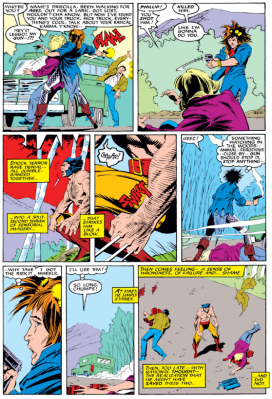
Wolverine doesn’t kill (Guice/Green)
Even Wolverine, who is again struggling with his animalistic regression during this two-parter, doesn’t kill when he has the chance in this story. In fact, since Wolverine’s battle with Lady Deathstrike, he’s being drawn to look older and more tired, and it’s reflected in the script. His transition into the wise old samurai is really taking shape now, and it’s interesting to now see what triggered this transition in the character. Wolverine will eventually be revealed to be extremely long-lived, with his healing power dramatically slowing his aging. Miller’s The Dark Knight Returns starred an old Bruce Wayne many years in the future coming out of retirement as Batman, and it’s possible this is where the Wolverine as a veteran superhero concept came from. Also interesting is that years later, this idea is carried further by Mark Millar and Steve McNiven’s Old Man Logan (and this year’s movie Logan), where an even older Wolverine roams the future Marvel Universe.
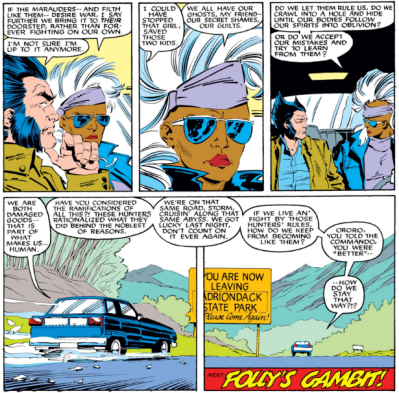
Storm and Wolverine question the team’s next steps (Guice/Green)
At the end of this two-parter, Storm is still reflecting on the attack from the Marauders and decides the X-Men need to take a more proactive approach. This more revolutionary or militaristic angle to superheroes will become the modus operandi for several comics in the future, including the X-Men spin-off title X-Force. The Avengers and Justice League comics will also sometimes take this approach, and it’s another concept I associate with the advent of this dark and gritty era.
The three World War II heroes are presented as ultra-conservative and some of the language particularly used by the Crimson Commando eerily echoes modern nationalistic messaging.
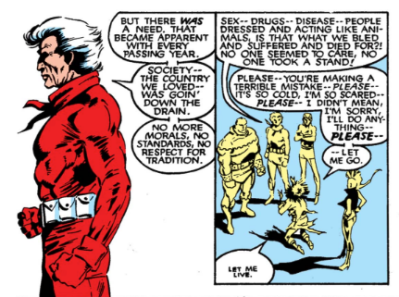
Crimson Commando justifies it all (Davis/Green)
Madelyne Pryor shows up in a subplot. She was seen, although not explicitly identified, several issues back being brought into a hospital as an unidentified Jane Doe. Through some flashbacks, we find out that she might’ve been one of the Marauders’ first targets, and after being in a coma for some time, now wakes up. In the interim, over in the pages of X-Factor, her husband Cyclops has left her to go back to superheroing. While editorially mandated so the original X-Men could be back together again, it will be a black mark on the character for a long time.
Alan Davis shows up against for the first half and is just wonderful. I especially love how he draws Storm here, which is good since she’s the central focus of the story. It really is too bad he wasn’t brought on as the main artist at this point but I think he was also working on Detective Comics at DC Comics at this point. Jackson Guice jumps in for the second part, as well as the first part of the next two-parter. He’s not as strong or distinct here as Alan Davis before him or the artist that comes next (more on him later). Guice is a fantastic artist but the first of two might’ve been a bit rushed or maybe not the best pairing with the inker. The second is good but he goes on to do much stronger work in his career (persona favorite: Ruse).
The next two-parter features the rest of the team, now relocated to Muir Island, a fictional location just northwest of Scotland. We’ve seen this place before, most prominently during the Proteus Saga from 1979. It is the site of a research and medical facility run by Dr. Moira MacTaggert, a scientific colleague and ex-girlfriend of the X-Men’s former mentor Professor Xavier (still presumed dead from mortal wounds when he was rushed off into deep space with his space girlfriend and her space pirate friends). All of the injured X-Men and surviving Morlocks from the Mutant Massacre were moved here for treatment. Moira is dating Banshee, who was a part of the X-Men before he lost his mutant powers of hollering. He never really resonated with me during his time on the team, in part because writer Chris Claremont went overboard with phonetically spelling his accent. But I liked him here, where he’s serving as a trainer for the new X-Men. It’s a brief appearance, so maybe that helps too.

Longshot eats “burned animal flesh and unborn baby birds” (Guice/Leialoha)
The new X-Men are training while Storm and Wolverine are off doing their thing. The new recruits have a lot of catching up to do. Rogue is the senior member, as she’s been around since 1983. The new members are:
- Psylocke – the telepath Betsy Braddock just joined toward the end of Mutant Massacre after surviving an attack from Sabretooth
- Dazzler – the pop singer Alison Blaire generates light and lasers out of sound, and while she’s been a friend to the X-Men since 1980, she finally joined in the Mutant Massacre epilogue when her career and reputation were destroyed by the possession of Malice
- Longshot – an extradimensional oddity who just joined in an Uncanny X-Men Annual that I don’t have
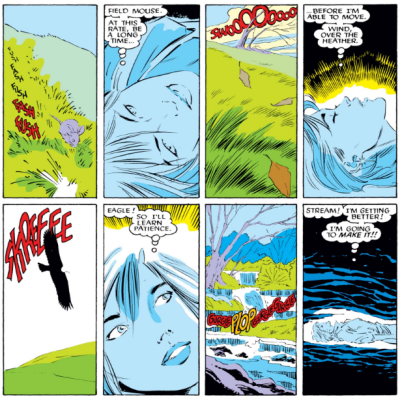
Cool sequence of Dazzler absorbing background noise to recharge (Silvestri/Green)
These three members replace longtime X-Men Nightcrawler, Colossus and Shadowcat, who were seriously injured during the Mutant Massacre. Psylocke was a supporting character in British Marvel comics but was largely unknown in the United States until her introduction in a recent New Mutants Annual story. Dazzler had a solo series of her own that ran for 5 years, but while the character first appeared in the pages of Uncanny X-Men, there didn’t appear to be a lot of readers that followed the character into her own adventures. Longshot had only been seen in his mini-series by Ann Nocenti (coincidentally, editor of Uncanny X-Men) and Art Adams (who is the cover artist of the second part of this two-parter), released in 1985. While these characters aren’t complete blank slates, it’s not unrealistic to assume these are complete strangers to readers. It’s a big gamble to jettison half the cast all at once, and this two-parter is dedicated to winning readers over on the new members, especially Dazzler.
Callisto is still around too, but mainly as a device to get Dazzler to storm off in a huff. She shows up in the last issue of this batch to be grumpy again, which seemed a little forced. But I guess if I lost all of my friends to a band of murderers, I’d probably be a little grumpy too.
It’s a bit odd that Dazzler gets the spotlight, as she and Psylocke were heavily featured revery recently when they joined the team. Longshot is the biggest stranger and since these issues are the first time he’s being seen in the main book, it’s strange how peripheral he comes across. I was largely won over by Psylocke last time, and while previously ambivalent, here I’m mostly won over by Dazzler. As you might expect from a one-time celebrity, she’s a bit of a diva, prone to tantrums, and really only on the team because she has no other options. It’s a unique approach to a superhero team member’s inclusion. She’s certainly not the first reluctant superhero or reluctant member of a superhero team by any means, but because of the higher calling intrinsic in the mutant rights aspect of being an X-Man, there is an extra layer to it that feels unique within these pages. It’s also funny that she runs into the Juggernaut (even if her recognizing him out of costume as he speeds by in a car is a little much), who happens to be a huge fan of hers.

Juggernaut is a closet Dazzler fan (Guice/Leialoha)
Of course, the four come together in time to defeat the Juggernaut and save some locals in Scotland. It’s a fun story that doesn’t feel incredibly consequential other than establishing these characters. Again, it feels a bit like a distraction from the impending Marauders threat, which is now starting to feel like maybe their attack on the Morlocks was it and the X-Men are just imagining that they’re still in danger.
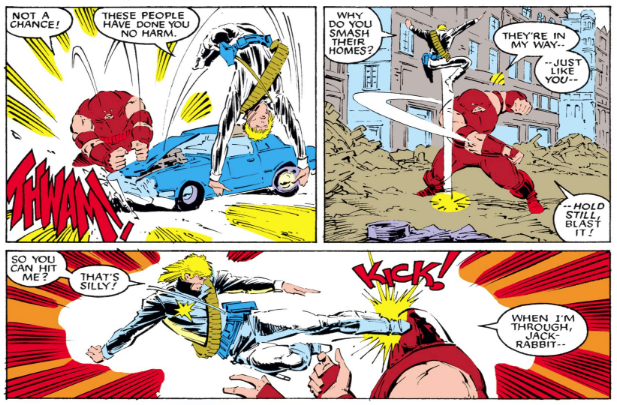
Longshot vs. Juggernaut (Silvestri/Green)
More noteworthy is the second half of this two-parter being drawn by Marc Silvestri. After one more fill-in artist, he will become the new regular artist on Uncanny X-Men, which has been rotating through a stable of fill-in artists since John Romita Jr.’s departure not even halfway through the Mutant Massacre. Silvestri is the first of a generation of artists that would become rock stars in the late 1980s and early ’90s, so I suppose it’s fitting in a way that his first issue of Uncanny X-Men focuses on the rock star Dazzler. Along with later stars Jim Lee, Todd McFarlane, Rob Liefeld, Whilce Portacio, Erik Larsen, and Jim Valentino, Silvestri will eventually help form Image Comics, a huge force in establishing creator-owned comics as a viable publishing strategy. As part of Image, he launched Cyberforce and eventually formed his own imprint, Top Cow Productions, which had huge success in the mid-’90s with Witchblade and The Darkness. But we’re getting ahead of ourselves. Here, Silvestri brings a refreshing look to the characters. There is a degree of fun to his layouts and characterizations that help counter the darker tones seeping into the book post-Mutant Massacre. He also has a sleek and sexy edge that prevents it from tipping into too silly. Maybe for the first time since John Byrne and Paul Smith, the characters just look cool doing what they’re doing. They’re expressive, dynamic, and it looks exciting. Really, his arrival is probably the best part of this batch of issues, although probably more for the promise of what is to come.
The last issue in this set brings Havok onto the team, which you’d think they would’ve done before the team-building two-parter with Juggernaut. Havok is Alex Summers, the younger brother of Cyclops, the first X-Man (retcons aside). Alex was first introduced way back in 1969, a couple of issues before the arrival of the legendary artist Neal Adams attempted to save the beleaguered original X-Men series from getting cancelled. Unfortunately it didn’t quite work, and the book was put on hiatus about a year later (and then successfully relaunched in 1975). But during that time, Alex was revealed to have the ability to convert ambient cosmic energy into cool looking blasts of concentric circles. Like his brother Alex, he has poor control over his powers. While he briefly served as an X-Man, he has mostly wanted to try to live a normal life. His girlfriend the green-haired Lorna Dane is also a mutant. Of course the two invariably get sucked back into mutant shenanigans and that’s exactly what happens here.
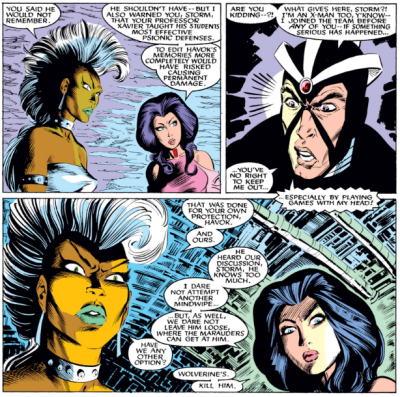
Suspicion and paranoia (Blevins/Green)
A few other odd things happen (or don’t happen) in this issue. First, the issue right before it ends on a cliffhanger of Alex and Lorna discovering one of the big fish that serve as the spaceships for The Brood (last seen during the Brood Saga). If the Brood are back, that is seriously bad news, and Alex and Lorna acknowledge this. Then, in the next issue, no mention of this is made whatsoever. It’s revealed during this issue that Alex’s memories were tampered with by Psylocke (more on that soon!) so it’s entirely possibly his memory of why he was going to visit the X-Men was erased too. But Lorna makes no mention of it either. Apparently this whole plot point is left dormant for years, which is crazy to me. Why introduce it the way it was if nothing is going to be done with it? Alex could go visit the X-Men for any number of reasons that lead to him joining. To me it is indicative of how Chris Claremont isn’t quite on top of things as a plotter as he once was. Smaller clues suggest that Claremont’s awareness of the character’s history, even history that he himself wrote, is not very strong. Again, this could be chocked up to Psylocke’s mind-wipe, but it seems like a convenient excuse rather than a choice made for the story.
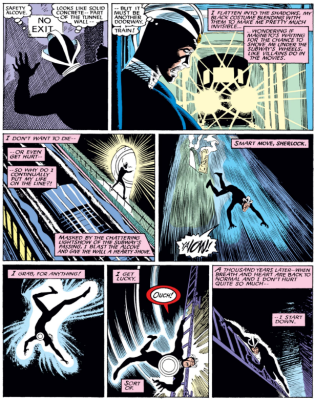
Havok twists and turns through his own paranioed confusion (Blevins/Green)
Despite this, the use of Alex’s narration and his discovery of his own former teammates’ treachery at altering his memory present a good tale of paranoia and increasing anxiety that also play into the post-Mutant Massacre tone the book is taking. Fill-in artist Bret Blevins provides a suitably creepy, twisted and unsteady style that really serves the story here. The X-Men gather in the abandoned tunnels of the Morlocks to plan how to fake their own deaths so the Marauders will leave them and their loved ones alone. This makes it seem like Storm might’ve changed her mind after deciding to be more proactive a few issues earlier. Although I guess there’s no real reason why both plans can’t still be in place.
Meanwhile, in case we forgot that the Marauders are still a threat, Lorna is being attacked by them, and is eventually taken over by the mind-controlling Malice. Ultimately, story is showing both Alex and Lorna as they’re forced back into the X-Men’s world, but end up on opposing sides. Neither is entirely making their choice of their own free will. One is straight-up mind-controlled, and the other is somewhat coerced and somewhat left with no other option.
Speaking of lack of free will: the mind-wipe. Years later, DC Comics revealed a similar mind-wipe among teammates in the pages of Identity Crisis by Brad Meltzer and Rags Morales. This was a big event for DC, and an extremely controversial moment. Here, it’s kind of brushed aside as a failed attempt to keep Alex safe and everyone moves on. It’s quite bizarre and reminiscent of Professor X’s ethically dubious use of his telepathy back in the very beginnings of the X-Men comic. This is a big red flag that the X-Men are losing their way without their mentor (who eventually took a more ethical approach to his powers).
Another controversial moment comes from Psylocke when she suggests killing Alex when Storm asks for any additional alternatives of what to do with him. From what I understand, this got a lot of angry letters but this didn’t ring as troubling for me. First, the story is told from Alex’s perspective and he’s obviously pretty suspicious and shaken. There’s always the unreliable narrator factor, and it’s clear his state of mind is frazzled and panicked, clouding his judgement and clarity. I don’t think the option was as seriously considered as he feared. Second, he’s only recently met Psylocke. Even Storm isn’t a close friend to him. So it’s very possible he’s misreading them. I think it’s more likely Psylocke is offering it as an improbable alternative to highlight that they really have very few options.
But even if she didn’t propose it as a genuine option, this is still another hint at what Psylocke will eventually become. Even in her previous encounter with Sabretooth, she longed to be tougher, and demonstrated a willingness to risk Wolverine to get information out of Sabretooth. There is a cold-bloodedness to her that is easily missed because of her pink costume and prim British appearance. So while I don’t think Alex was in any real danger of being murdered by the X-Men, it is a clue of what Betsy will become.
That kind of disciplined foreshadowing is what makes writer Chris Claremont impressive. But at the same time, plots get away from him, and juggling the hints and mysteries he’s setting up can clearly get away from him. There is something to be said for clarity and straightforward storytelling without all of the winding diversions and distractions. This batch of issues was a mixed bag of his strengths and weaknesses colliding.
Amid this transitional period, letterer Tom Orzechowski and colorist Glynis Oliver continue to be the bedrock of the series. As artists come and go, they have held down the fort for years now. Orzechowski has been on the book since 1977 and Oliver since 1978 with only occasional interruptions. With about a decade on the book each, they’re both only surpassed by writer Chris Claremont’s legendary duration. Just look at the colors above that add to Blevins’ bug-eyed delusions, and the lettering that sells the scene of Dazzler using countryside sounds to recharge herself. Those are some of the more obvious displays of their talent, but they are continually serving the stories and characters well with their skills.
Next time: Marc Silvestri officially settles in as the main artist in the build-up to the next crossover event.
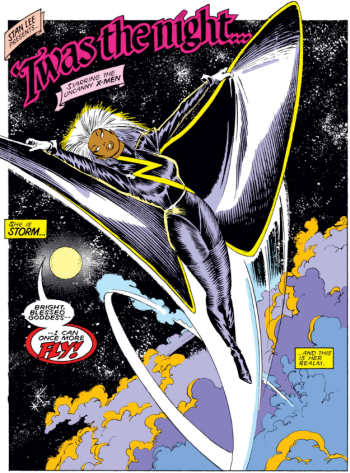
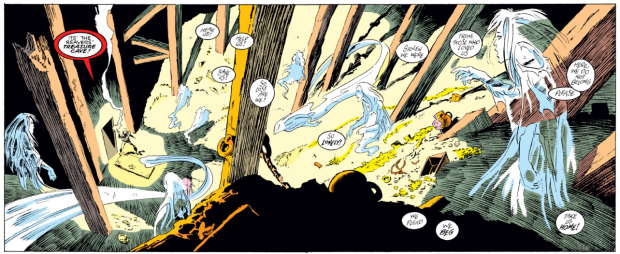
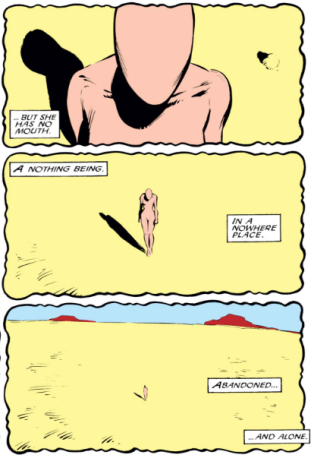 Probably the best part was a twisted dream sequence of Madelyne Pryor getting stripped of her baby and her own facial features, which are given over to a blank cypher to restore “the original,” Jean Grey. It’s during these scenes that she ends up aligning with the demonic S’ym because she thinks she’s just dreaming. It’s messed up and positions the character for the Inferno event but it’s a cool visual.
Probably the best part was a twisted dream sequence of Madelyne Pryor getting stripped of her baby and her own facial features, which are given over to a blank cypher to restore “the original,” Jean Grey. It’s during these scenes that she ends up aligning with the demonic S’ym because she thinks she’s just dreaming. It’s messed up and positions the character for the Inferno event but it’s a cool visual.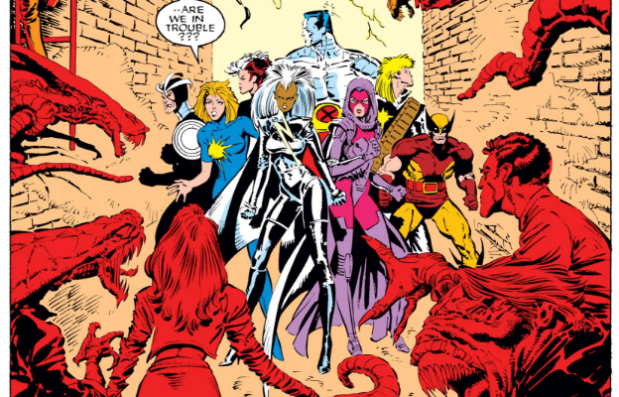
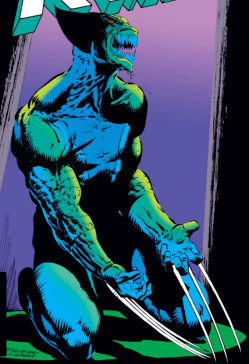

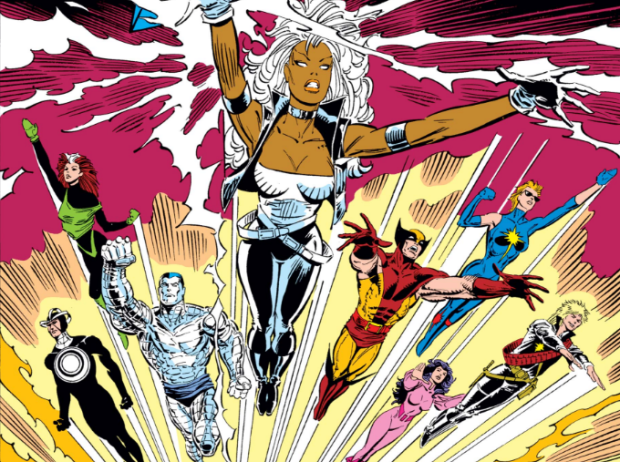
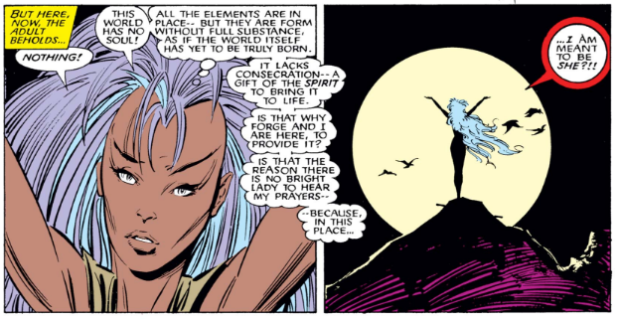
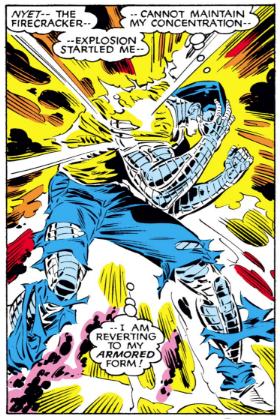
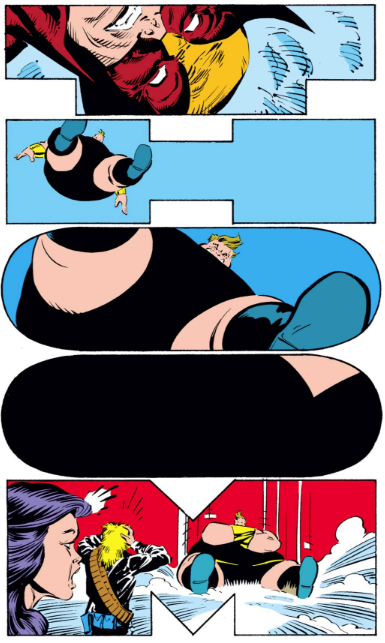
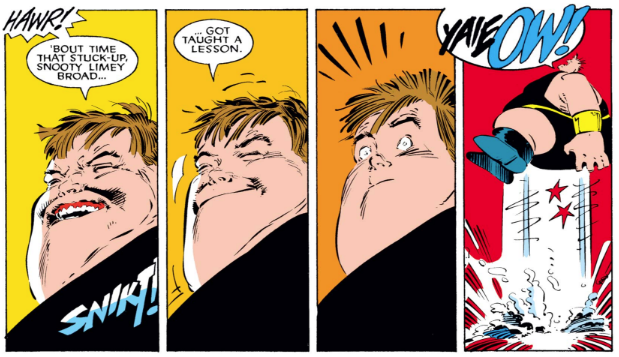
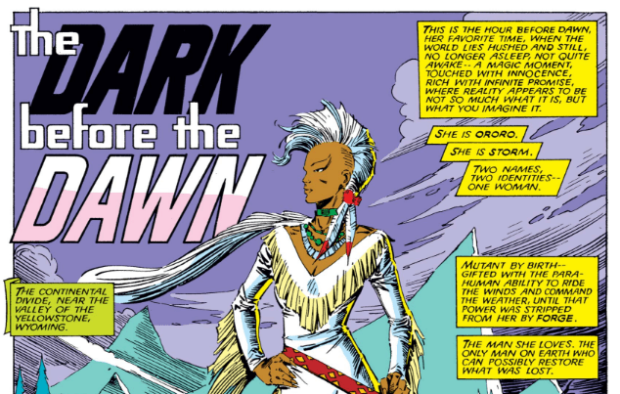
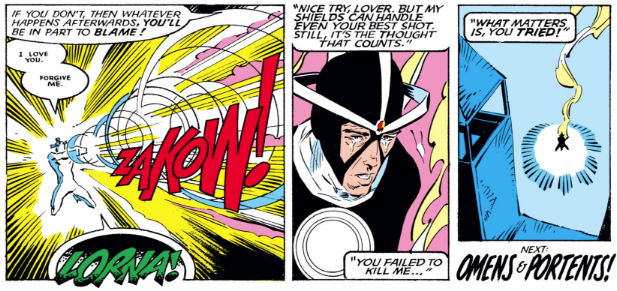
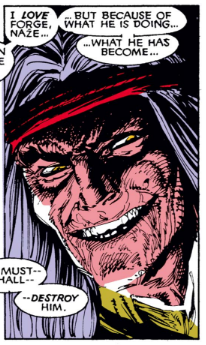
 Speaking of the Marauders, this batch of issues features the introduction of Mr. Sinister. This villain was teased as the mastermind behind the murder of the Morlocks during the Mutant Massacre. (Wow, there are a lot of m’s!) He is quickly established as being very powerful, easily subduing Sabretooth. This becomes a common trick. Whenever you want to establish a new character as a big deal, have him easily handle one of the cool characters like Wolverine or Sabretooth. Mr. Sinister is a goofy name, and apparently the original plan was that he was going to be the manifestation of a little boy’s idea of a bad guy. That also fits in with the crazy flamboyant design of the character, complete with jagged teeth and a cape made of streamers. At this point, we don’t get any real clarity on why he wanted the Morlocks killed, but now he’s obsessed with eliminating Madelyne Pryor, who ends up semi-joining the X-Men in this arc.
Speaking of the Marauders, this batch of issues features the introduction of Mr. Sinister. This villain was teased as the mastermind behind the murder of the Morlocks during the Mutant Massacre. (Wow, there are a lot of m’s!) He is quickly established as being very powerful, easily subduing Sabretooth. This becomes a common trick. Whenever you want to establish a new character as a big deal, have him easily handle one of the cool characters like Wolverine or Sabretooth. Mr. Sinister is a goofy name, and apparently the original plan was that he was going to be the manifestation of a little boy’s idea of a bad guy. That also fits in with the crazy flamboyant design of the character, complete with jagged teeth and a cape made of streamers. At this point, we don’t get any real clarity on why he wanted the Morlocks killed, but now he’s obsessed with eliminating Madelyne Pryor, who ends up semi-joining the X-Men in this arc.
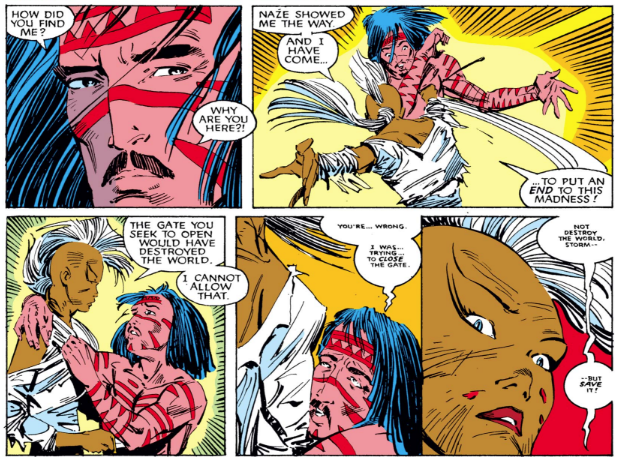
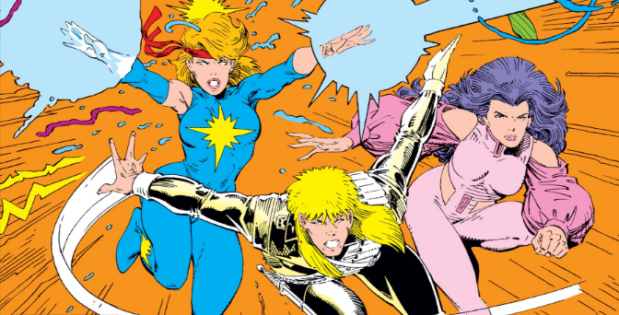










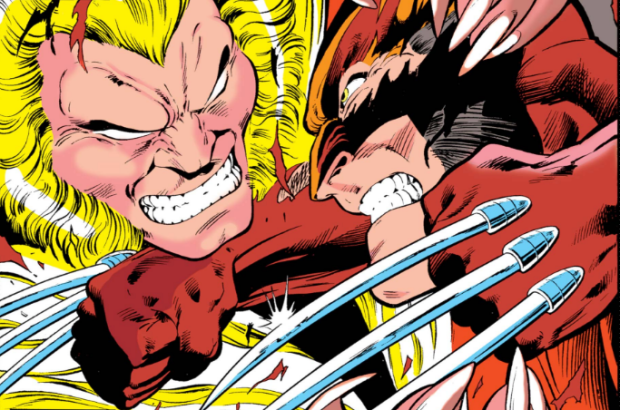
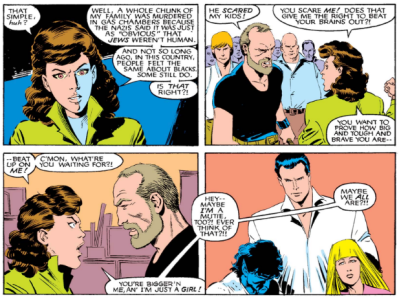

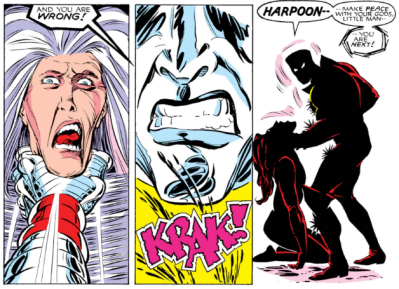
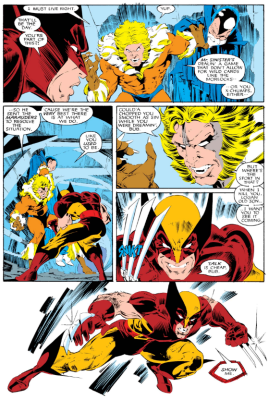
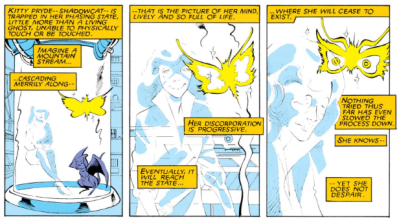

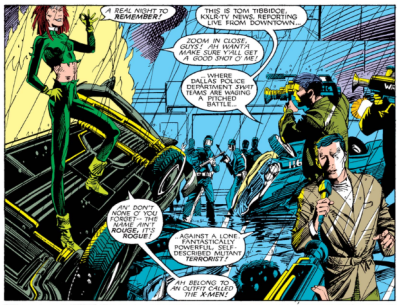
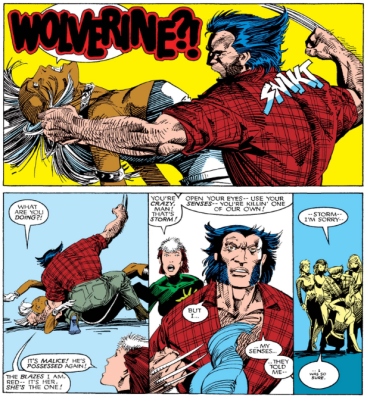
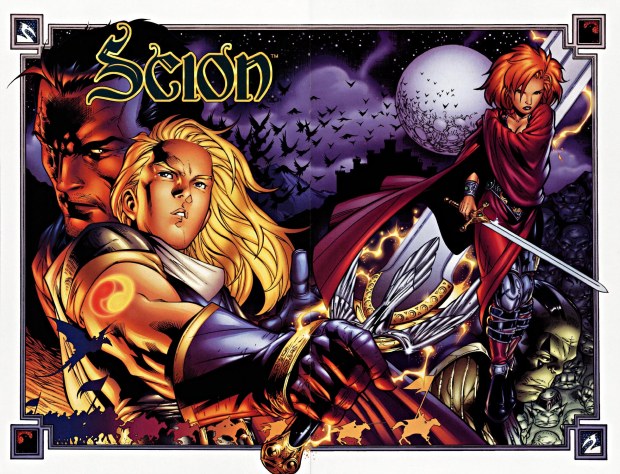
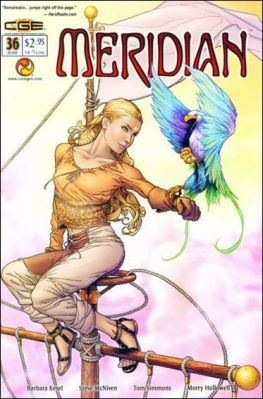 Soooo… for context, CrossGen Comics was a comic book publisher that ran in the late 1990s and early 2000s. At the time, I was pretty burnt out on Marvel. They offered a great alternative without being too alternative. They were mostly action/adventure tales using similar storytelling techniques seen in superhero comics but they were set in different genre trappings or remixes, like sci-fi, high fantasy, Victorian mystery, kung-fu, etc. Like Marvel and DC, the comics were all set in the same universe, but to give breathing room, independence and accessibility, each comic was set on a different planet, instead of a different city or part of New York. This allowed a lot of unique world building and stylistic freedom. But because there was some shared mythology and the possibility to visit other planets, it still had the appeal of shared universes. For the most part, this allowed readers to read as little or as much of the publisher’s line as they wanted. When characters did crossover, they were initially very good at presenting it so it held up regardless of how much of the line you read.
Soooo… for context, CrossGen Comics was a comic book publisher that ran in the late 1990s and early 2000s. At the time, I was pretty burnt out on Marvel. They offered a great alternative without being too alternative. They were mostly action/adventure tales using similar storytelling techniques seen in superhero comics but they were set in different genre trappings or remixes, like sci-fi, high fantasy, Victorian mystery, kung-fu, etc. Like Marvel and DC, the comics were all set in the same universe, but to give breathing room, independence and accessibility, each comic was set on a different planet, instead of a different city or part of New York. This allowed a lot of unique world building and stylistic freedom. But because there was some shared mythology and the possibility to visit other planets, it still had the appeal of shared universes. For the most part, this allowed readers to read as little or as much of the publisher’s line as they wanted. When characters did crossover, they were initially very good at presenting it so it held up regardless of how much of the line you read. So what happened? Long story short (too late), the company overreached. The CEO’s ambitions outstretched the limitations of the comics industry at the time. Plus, from what I understand from various interviews, there were some significant clashing of egos at the CrossGen Compound in regards to how much the shared universe elements should play a part in each book. Risks were taken that didn’t pay off. Paychecks started to slow down. Creators started to leave. Finally, they went into bankruptcy. Because of the corporate structure, all of the properties were either fully or partially owned by CrossGen (aside from a few partnerships with other publishers). When the properties went to auction, Disney’s Hyperion Books showed up and bought the entire line just so they could get J.M. DeMatteis and Mike Ploog’s Abadazad, a beautiful fantasy series that riffed on classic children’s books like Alice’s Adventures in Wonderland and The Wonderful Wizard of Oz. The comic was a late entry in the publisher’s output intended for an imprint set outside the CrossGen Universe line. Only 3 issues were published before the company went under. The book was relaunched by Hyperion Books in 2006 as a comics/illustrated children’s book hybrid that sadly didn’t find an audience and was discontinued after the third book in the series. Also in 2006, Checker Books licensed reprint rights to try to get unreleased collected editions to market. At the time, there were rumors of Checker trying to also publish unreleased stories, such as the highly anticipated Negation War. But alas, Checker seemed poorly equipped to really promote the line properly and their production quality couldn’t match the original books. Plus, the bad taste of the company’s end was probably still too fresh.
So what happened? Long story short (too late), the company overreached. The CEO’s ambitions outstretched the limitations of the comics industry at the time. Plus, from what I understand from various interviews, there were some significant clashing of egos at the CrossGen Compound in regards to how much the shared universe elements should play a part in each book. Risks were taken that didn’t pay off. Paychecks started to slow down. Creators started to leave. Finally, they went into bankruptcy. Because of the corporate structure, all of the properties were either fully or partially owned by CrossGen (aside from a few partnerships with other publishers). When the properties went to auction, Disney’s Hyperion Books showed up and bought the entire line just so they could get J.M. DeMatteis and Mike Ploog’s Abadazad, a beautiful fantasy series that riffed on classic children’s books like Alice’s Adventures in Wonderland and The Wonderful Wizard of Oz. The comic was a late entry in the publisher’s output intended for an imprint set outside the CrossGen Universe line. Only 3 issues were published before the company went under. The book was relaunched by Hyperion Books in 2006 as a comics/illustrated children’s book hybrid that sadly didn’t find an audience and was discontinued after the third book in the series. Also in 2006, Checker Books licensed reprint rights to try to get unreleased collected editions to market. At the time, there were rumors of Checker trying to also publish unreleased stories, such as the highly anticipated Negation War. But alas, Checker seemed poorly equipped to really promote the line properly and their production quality couldn’t match the original books. Plus, the bad taste of the company’s end was probably still too fresh.